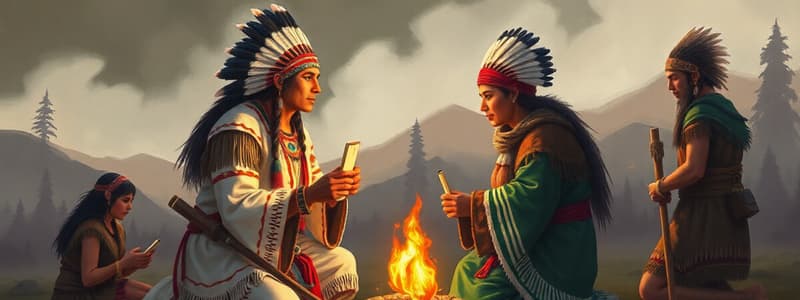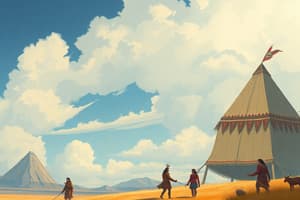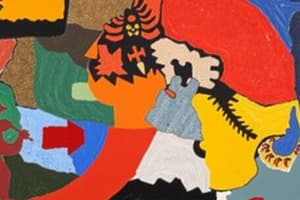Podcast
Questions and Answers
What is the primary purpose of a Vision Quest in Mi'kmaq culture?
What is the primary purpose of a Vision Quest in Mi'kmaq culture?
- To acquire spiritual guidance and discover one's life purpose. (correct)
- To demonstrate physical strength and endurance.
- To obtain material wealth and prosperity.
- To learn traditional crafting and artistic skills.
Which of the following best describes the role of smudging within the Mi'kmaq tradition?
Which of the following best describes the role of smudging within the Mi'kmaq tradition?
- An optional and minor practice used for decoration.
- Purely a social gathering to share stories and meals.
- A method to cleanse spaces and individuals of negative influences. (correct)
- A form of competitive sporting event to showcase agility.
How does smudging contribute to an individual's well-being?
How does smudging contribute to an individual's well-being?
- By providing a form of intense physical activity.
- By learning and practicing advanced horticultural techniques.
- By generating financial benefits and social prestige.
- By promoting cleansing, healing, spiritual clarity, and connecting with ancestors. (correct)
What is the purpose of burning herbs during the smudging ceremony?
What is the purpose of burning herbs during the smudging ceremony?
Which of these options best describes systemic racism?
Which of these options best describes systemic racism?
What was a primary goal of the government's enfranchisement policy concerning Indigenous peoples?
What was a primary goal of the government's enfranchisement policy concerning Indigenous peoples?
What was a significant consequence for Indigenous individuals who underwent enfranchisement?
What was a significant consequence for Indigenous individuals who underwent enfranchisement?
During a Vision Quest, in what form might the seeker receive a vision?
During a Vision Quest, in what form might the seeker receive a vision?
Which of the following describes the main purpose of a Vision Quest?
Which of the following describes the main purpose of a Vision Quest?
What is the appropriate sequence of steps involved in a Vision Quest as described?
What is the appropriate sequence of steps involved in a Vision Quest as described?
What was the primary goal of the Canadian government's White Paper on Indian Policy?
What was the primary goal of the Canadian government's White Paper on Indian Policy?
Which of the following did the White Paper propose to eliminate?
Which of the following did the White Paper propose to eliminate?
Who was the Indian Affairs minister that presented the White Paper to the House of Commons?
Who was the Indian Affairs minister that presented the White Paper to the House of Commons?
What was the immediate reaction of First Nations organizations to the White Paper on Indian Policy?
What was the immediate reaction of First Nations organizations to the White Paper on Indian Policy?
What was one of the intended consequences of eliminating Indian status according to the White Paper?
What was one of the intended consequences of eliminating Indian status according to the White Paper?
What was the stated intention of the White Paper in making First Nations people 'official Canadian citizens'?
What was the stated intention of the White Paper in making First Nations people 'official Canadian citizens'?
What specific action regarding Indian agents occurred in the same year the White Paper was released?
What specific action regarding Indian agents occurred in the same year the White Paper was released?
What was the direct result of strong opposition to the White Paper?
What was the direct result of strong opposition to the White Paper?
What was the primary goal of the Canadian government's 'White Paper' policy?
What was the primary goal of the Canadian government's 'White Paper' policy?
What was the primary response of Indigenous leaders to the 'White Paper' policy?
What was the primary response of Indigenous leaders to the 'White Paper' policy?
According to the provided information, what role do oral histories play in Mi'kmaw culture?
According to the provided information, what role do oral histories play in Mi'kmaw culture?
Which of the following best describes the goals of the Residential School system?
Which of the following best describes the goals of the Residential School system?
What material was primarily used to cover the exterior of Mi'kmaw wigwams, and why?
What material was primarily used to cover the exterior of Mi'kmaw wigwams, and why?
What was one of the main functions of elders within the Mi'kmaw community?
What was one of the main functions of elders within the Mi'kmaw community?
How did residential schools impact Mi'kmaw religious practices?
How did residential schools impact Mi'kmaw religious practices?
What is the meaning of the phrase 'assimilate Indigenous children' in the context provided?
What is the meaning of the phrase 'assimilate Indigenous children' in the context provided?
During smudging, which of the following is NOT a purpose of the smoke?
During smudging, which of the following is NOT a purpose of the smoke?
According to Mi'kmaw tradition, what role do shadows play?
According to Mi'kmaw tradition, what role do shadows play?
What is the significance of the south direction in Mi'kmaw culture?
What is the significance of the south direction in Mi'kmaw culture?
What is the role of the north direction in Mi'kmaw teachings?
What is the role of the north direction in Mi'kmaw teachings?
Which of the following is NOT directly associated with the creation of Glooscap?
Which of the following is NOT directly associated with the creation of Glooscap?
What does the term 'Metis' refer to in the Canadian context?
What does the term 'Metis' refer to in the Canadian context?
Which of the following is a key function of the Indian Act?
Which of the following is a key function of the Indian Act?
What did the Indian Act do in relation to Indigenous peoples' rights?
What did the Indian Act do in relation to Indigenous peoples' rights?
What authority did Indian Agents possess regarding First Nations governance?
What authority did Indian Agents possess regarding First Nations governance?
Until the mid-1950s, what restriction was placed on First Nations people by Indian Agents?
Until the mid-1950s, what restriction was placed on First Nations people by Indian Agents?
What best describes the impact of the Indian Act regarding control over First Nations communities?
What best describes the impact of the Indian Act regarding control over First Nations communities?
Which of the following best defines ‘Colonialism’?
Which of the following best defines ‘Colonialism’?
What is one of the main goals of Restorative Justice programs?
What is one of the main goals of Restorative Justice programs?
What practice resulted from the ‘Sixties Scoop’?
What practice resulted from the ‘Sixties Scoop’?
How did the actions of Indian Agents directly undermine First Nations communities?
How did the actions of Indian Agents directly undermine First Nations communities?
What is a common outcome of colonial practices on indigenous communities?
What is a common outcome of colonial practices on indigenous communities?
Flashcards
What was Enfranchisement?
What was Enfranchisement?
Enfranchisement was a forced policy implemented by the Canadian government that aimed to assimilate Indigenous people into the dominant settler society by stripping them of their status, rights, and cultural identity.
What was the main goal of Enfranchisement?
What was the main goal of Enfranchisement?
The government intended to reduce the number of Indigenous people recognized as "Status Indians," decreasing government responsibilities towards Indigenous communities.
What were the consequences of Enfranchisement?
What were the consequences of Enfranchisement?
Enfranchisement often required Indigenous people to abandon their culture, language, and community ties, aligning them with settler norms and reducing resistance.
What is a Vision Quest?
What is a Vision Quest?
Signup and view all the flashcards
What are the goals of a Vision Quest?
What are the goals of a Vision Quest?
Signup and view all the flashcards
Vision Quest in Mi'kmaq Culture
Vision Quest in Mi'kmaq Culture
Signup and view all the flashcards
Smudging in Mi'kmaq Culture
Smudging in Mi'kmaq Culture
Signup and view all the flashcards
Systemic Racism
Systemic Racism
Signup and view all the flashcards
The Importance of Smudging
The Importance of Smudging
Signup and view all the flashcards
The Ritual of Smudging
The Ritual of Smudging
Signup and view all the flashcards
What was the White Paper on Indian Policy?
What was the White Paper on Indian Policy?
Signup and view all the flashcards
What were the key proposals of the White Paper?
What were the key proposals of the White Paper?
Signup and view all the flashcards
How did Indigenous leaders react to the White Paper?
How did Indigenous leaders react to the White Paper?
Signup and view all the flashcards
Why was the White Paper considered harmful to Indigenous communities?
Why was the White Paper considered harmful to Indigenous communities?
Signup and view all the flashcards
What was the asserted rationale behind the White Paper?
What was the asserted rationale behind the White Paper?
Signup and view all the flashcards
What was the outcome of the White Paper?
What was the outcome of the White Paper?
Signup and view all the flashcards
How was the White Paper connected to the Indian Act?
How was the White Paper connected to the Indian Act?
Signup and view all the flashcards
What was the White Paper's perspective on equality?
What was the White Paper's perspective on equality?
Signup and view all the flashcards
The White Paper
The White Paper
Signup and view all the flashcards
The Red Paper
The Red Paper
Signup and view all the flashcards
Mi'kmaq Oral History
Mi'kmaq Oral History
Signup and view all the flashcards
Residential Schools
Residential Schools
Signup and view all the flashcards
Wigwam
Wigwam
Signup and view all the flashcards
Elders
Elders
Signup and view all the flashcards
Vision Quest
Vision Quest
Signup and view all the flashcards
Enfranchisement
Enfranchisement
Signup and view all the flashcards
Indian Agent
Indian Agent
Signup and view all the flashcards
Colonialism
Colonialism
Signup and view all the flashcards
Doctrine of Discovery
Doctrine of Discovery
Signup and view all the flashcards
Sixties Scoop
Sixties Scoop
Signup and view all the flashcards
Restorative Justice
Restorative Justice
Signup and view all the flashcards
Removal of Chiefs and Band Councilors
Removal of Chiefs and Band Councilors
Signup and view all the flashcards
Restrictions on Leaving Reserves
Restrictions on Leaving Reserves
Signup and view all the flashcards
What is Smudging?
What is Smudging?
Signup and view all the flashcards
What is the significance of thanking the seven directions during Smudging?
What is the significance of thanking the seven directions during Smudging?
Signup and view all the flashcards
What is the significance of the sweetgrass smoke in Smudging?
What is the significance of the sweetgrass smoke in Smudging?
Signup and view all the flashcards
Who is Glooscap?
Who is Glooscap?
Signup and view all the flashcards
How was Glooscap created?
How was Glooscap created?
Signup and view all the flashcards
What is the significance of Glooscap spinning seven times?
What is the significance of Glooscap spinning seven times?
Signup and view all the flashcards
What is the Indian Act?
What is the Indian Act?
Signup and view all the flashcards
What are the criticisms of the Indian Act?
What are the criticisms of the Indian Act?
Signup and view all the flashcards
Study Notes
Stereotype
- Unfair, inaccurate generalizations about a group of people based on characteristics.
Peace and Friendship Treaties
- Agreements signed between settlers and Indigenous peoples.
- Often formalized to guarantee Indigenous neutrality or allies.
- Example: 1752 agreement between Jean Baptiste Cope (Mi'kmaq Grand Chief) and the Governor of Nova Scotia.
- In 1993, October was declared Mi'kmaq History Month.
Potlatch
- Ceremonial feasts used to confirm titles, celebrate events (marriages, adoptions), and redistribute wealth.
- Demonstrates wealth, status, and community connections.
- Gifts are distributed or destroyed to show generosity.
- Used for naming ceremonies, marriages, and mourning.
Enfranchisement
- Process where Indigenous individuals gained Canadian citizenship rights, usually by abandoning Indigenous status.
- Government aimed to reduce "Status Indians" to decrease costs.
- Required Indigenous people to adopt settler norms and abandon their culture.
Vision Quest
- Spiritual journey to seek guidance, usually through fasting, isolation, dreams, or visions.
- Occurs for reasons like illness, personal doubt, or puberty.
- Involves preparing a sacred place and seeking guidance from a spirit or animal.
Smudging
- Ceremony using herbs (sage, sweetgrass, cedar) to purify a space, person, or object.
- Removes negative energy.
- Form of communication with ancestors and spiritual realms.
- Promotes healing, spiritual clarity, and balance.
Systemic Racism
- Racism embedded in systems, laws, or policies that perpetuate unfair treatment
- Widespread unfair treatment of people.
White Paper
- Canadian government policy proposing assimilation of Indigenous people.
- Called for the complete assimilation of First Nations people into Canadian Society.
- Repealed existing policies and treaty obligations, while transferring responsibility to the provinces.
- The policy was met with strong opposition and eventually was withdrawn.
Oral History
- Traditional stories and legends passed down through generations.
- Method of preserving culture and history.
- Used to explain past events and create understanding of the past.
Residential Schools
- Schools designed to assimilate Indigenous children, often away from their families.
- Cultural and traditional practices were often forbidden and replaced with Catholic beliefs
- Often involved abuse, neglect, and trauma.
Wigwam
- Traditional Mi'kmaq house built by women.
- Constructed with spruce poles covered in birch bark.
- Commonly used as homes.
- Often considered waterproof and portable.
Elder
- Important community members with crucial roles.
- Teach children, offer daily life advice, be keepers of traditional knowledge and wisdom.
- Act as advisors and guides in spiritual matters.
Smudging
- Method of spiritual purification and cleansing.
- Using herbs like sage, sweetgrass, and cedar to create smoke, which is believed to cleanse negative energy.
Centralization
- Policy that sought to eliminate or decrease the roles of Indian agents in government and to consolidate reserves.
- Often reduced resources available on the reserves.
The Sixties Scoop
- Forced removal of Indigenous children from their families and placed in non-Indigenous homes.
- Done in an attempt to assimilate Indigenous children into the Canadian society.
Restorative Justice
- Approach to justice that focuses on repairing harm and rebuilding communities.
- Aimed at reconciliation and rehabilitation, rather than punishment.
- Reintegrates and empowers those harmed and those causing harm.
Doctrine of Discovery
- European right to land based on the ideology that Christians had a superior claim to land.
- Disregarded existing Indigenous governance and land rights.
- Justification for the European takeover of indigenous land.
The Columbian Exchange
- Exchange of plants, animals, and diseases between the Old and New Worlds.
- Often a one-way flow from Europe to the Americas.
- Involved cultural exchange, but also the spread of diseases impacting indigenous populations.
Indian Act
- Federal legislation covering many aspects of Indigenous people's lives.
- Often used as an instrument for policies, such as assimilation.
- Established and determined who is considered a status Indian.
- Over time, it's been amended numerous times but retained considerable policy implications.
Indian Agent
- Representatives of the federal government on Indigenous reserves.
- Played significant roles in enforcing policies (often paternalistic) on Indigenous peoples.
Studying That Suits You
Use AI to generate personalized quizzes and flashcards to suit your learning preferences.




